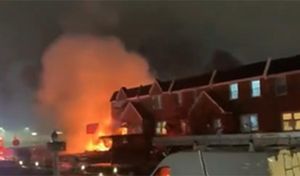A tragic midair collision occurred between an Army helicopter and an American Airlines flight near Washington, D.C., resulting in the death of all 67 people aboard the two aircraft. The incident marks the deadliest U.S. air crash since 2001, as investigators scramble to piece together the events leading up to the disaster.
On January 29, 2025, the collision happened as the American Airlines flight was on its final approach to Ronald Reagan National Airport. The flight was coming from Kansas, carrying 60 passengers and four crew members. At the same time, the Army helicopter, which was also involved, had three soldiers on board. Despite the clear conditions, the two aircraft were on a deadly collision course.
John Donnelly, Fire Chief of Washington, D.C., reported, "We are now at the point where we are switching from a rescue operation to a recovery operation." Early efforts to retrieve victims were severely hampered by the icy waters of the Potomac River, where first responders located at least 28 bodies.
The wreckage from the collision was discovered scattered across the river. Reports indicate the plane was found overturned and broken apart, submerged waist-deep, with first responders searching areas of the Potomac as far south as the Woodrow Wilson Bridge, roughly three miles from the airport.
American Airlines CEO Robert Isom stated, "On final approach to Reagan National, it collided with a military aircraft on an otherwise normal approach." His comments shed some light on the operations occurring at the time of the crash, but there remains significant scrutiny surrounding why the military helicopter flew directly onto the jet's path. Officials from the Federal Aviation Administration (FAA) reported staffing levels at the air traffic control tower were "not normal" during the time of the incident, hinting at possible underlying issues within air traffic management.
Further insights from Jonathan Koziol, Chief of Staff for Army aviation, revealed the helicopter's crew was very experienced. He noted, "Both pilots had flown this specific route before, at night. This wasn't something new to either one of them." Koziol emphasized the crew's familiarity with the congested flying conditions around Washington, which raises questions about the circumstances leading to such a catastrophic collision.
The NTSB is currently leading the investigation, holding its first news conference about the incident on January 30, 2025, just one day after the collision. Investigators aim to determine factors contributing to the crash, including any issues with air traffic control, pilot decisions, and procedural adherence. The findings will be pivotal for evaluating air traffic safety and ensuring such tragedies do not occur again.
This collision has sparked concerns about aviation safety and air traffic control staffing procedures. Recent tremors of errors and delays among air traffic controllers during high-volume travel times have raised alarm. Many are anxiously waiting to see whether these operational challenges had any effect on the events leading to the January 29 catastrophe.
Experts insist on the importance of assessing processes to maintain safety standards. Following high-profile accidents, investigations by agencies such as the NTSB typically serve as key opportunities for insights and improvements, facilitating safety evaluations on broader aviation protocols.
With the aviation community and victims' families processing the tragic loss from this event, the focus will soon shift to the long-term impacts on air travel norms and potential regulatory changes. This event could potentially impact how both military and civilian aircraft are managed as they navigate through major airspaces. Regulatory agencies and aircraft operators will likely review operating protocols comprehensively for all segments of aviation.
The search for answers following the midair collision continues as the NTSB works diligently to piece together the events of the tragic day. Families of the deceased are left to mourn their loved ones, as the aviation community and public hold their breath for the reports to come, with hopes safety enhancements will emerge from the disaster.



